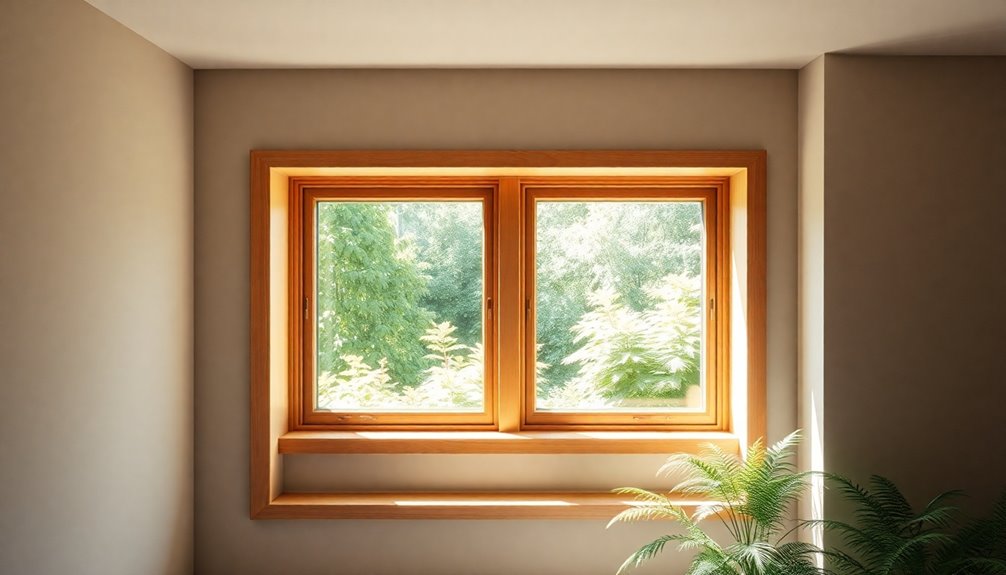Non-venting basement windows are a fantastic eco-friendly alternative that brings in natural light while boosting energy efficiency. These windows are made from durable materials and feature energy-efficient glass, reducing heat loss and lowering your energy bills. They require minimal maintenance and can be complemented with passive ventilation solutions. By choosing these windows, you protect your home from humidity and mold while creating a healthier living space. Explore more options to enhance your home's efficiency and sustainability.
Understanding Non-Venting Basement Windows
When you're considering basement windows, understanding non-venting options is essential. Non-venting basement windows offer natural light and comply with safety regulations without the ability to open. They typically feature energy-efficient glass, like low-E coatings, which helps minimize heat loss and enhances insulation. This makes them perfect for maintaining a comfortable temperature in below-grade spaces. Additionally, selecting windows from retailers that prioritize sustainable packaging solutions can further enhance your commitment to eco-friendly building practices.
Constructed from durable materials like vinyl or fiberglass, these windows require minimal maintenance and resist moisture and rot. Plus, many options on the market are eco-friendly, featuring frames made from recycled materials and designs that promote energy efficiency. Choosing brands that emphasize ethical manufacturing practices ensures that your window selection aligns with sustainable practices, which can significantly contribute to a more eco-friendly home environment.
Importance of Basement Ventilation
Proper basement ventilation is key to keeping humidity in check and preventing mold growth, which can pose health risks. You'll want to guarantee fresh air circulates to avoid allergens and odors that could affect your well-being. Additionally, effective ventilation can enhance operational costs by reducing the need for extensive mold remediation and improving air quality. Implementing automated notifications for regular maintenance checks can further ensure that your ventilation system operates efficiently. Regular checks of financial health can also help in budgeting for necessary home improvements and maintenance.
Health Risks of Humidity
Humidity in your basement can pose significant health risks if left unchecked, as excess moisture creates the perfect breeding ground for mold and mildew.
High humidity levels affect indoor air quality, triggering respiratory issues in sensitive individuals, including asthma and allergies. When the air is damp, it can trap dust, allergens, and pollutants, worsening health problems and reducing overall comfort in your home.
Additionally, radon gas, a naturally occurring radioactive gas, can accumulate in high-humidity environments, posing serious health risks.
Maintaining a proper ventilation system and controlling humidity in your basement is essential for preventing these dangers and ensuring a safe living environment for everyone.
Don't underestimate the importance of ventilation in protecting your health and home.
Mold Prevention Strategies
To keep mold at bay, effective basement ventilation is crucial. Maintaining humidity levels below 60% is essential to prevent mold growth in enclosed spaces.
You can achieve this by installing ventilation systems like extractor fans that remove excess moisture, especially during activities like laundry or cooking. Incorporating basement windows can also help, allowing for fresh air circulation when weather permits.
Aim for regular air exchanges—ideally 10 times a day—using systems like the EZ Breathe to expel stale, humid air.
Additionally, guarantee proper vapor barriers and insulation in your basement to minimize moisture infiltration from the ground.
Together, these strategies create a less inviting environment for mold, promoting a healthier home.
Importance of Fresh Air
While many homeowners focus on aesthetics and insulation, the importance of fresh air in your basement can't be overlooked. Proper ventilation promotes fresh air circulation, preventing damp air that can lead to mold and mildew.
High humidity levels not only affect your indoor air quality but can also cause structural damage, resulting in costly repairs. By ensuring good airflow, you reduce dust, allergens, and odors, creating a healthier living environment.
Additionally, a poorly ventilated basement can trap hazardous radon gas, posing serious health risks. Implementing energy-efficient home improvements like exhaust fans or the EZ Breathe system can enhance air quality, conducting up to 10 air exchanges daily.
Prioritize fresh air to protect your home and health.
Eco-Friendly Ventilation Techniques
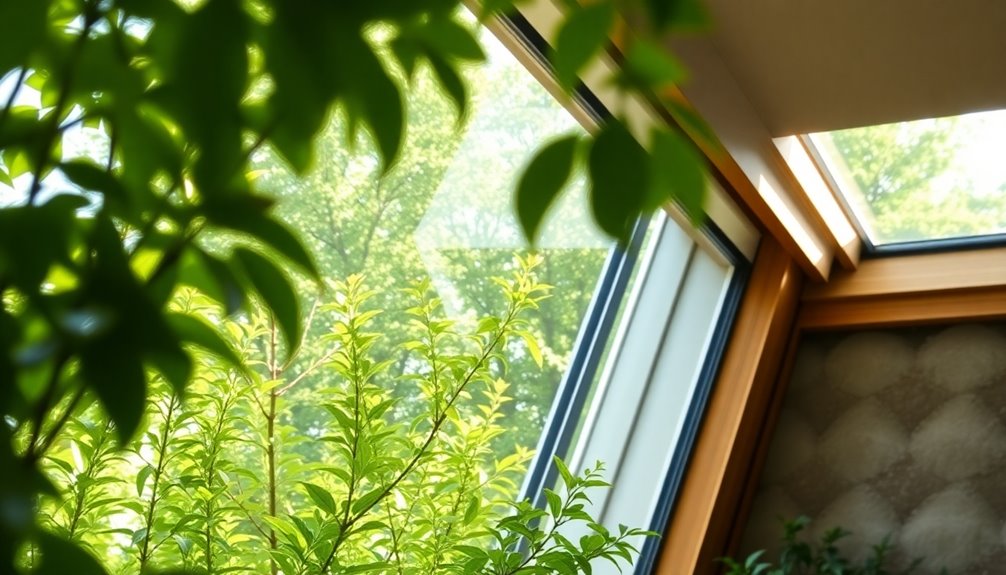
Since maintaining a healthy basement environment is essential, eco-friendly ventilation techniques offer effective solutions that minimize energy consumption.
Consider using passive vents, which regulate airflow naturally without needing power. This sustainable choice enhances air circulation while keeping energy use low. Additionally, implementing efficient financial management practices can help homeowners prioritize investments in eco-friendly solutions. Utilizing bill tracking tools can also assist in managing expenses related to these investments.
Dehumidifiers are another excellent option; they manage moisture levels efficiently, promoting a healthier space with less energy than traditional methods.
Solar-powered ventilators harness renewable energy, improving air circulation and reducing reliance on grid electricity.
You can also install energy-efficient extractor fans designed to remove excess moisture and stale air while consuming minimal power.
Finally, incorporating perforated building materials like air bricks during construction can enhance airflow without mechanical assistance, making it an innovative, eco-friendly solution for your basement. Additionally, understanding the importance of financial literacy can help homeowners make informed decisions about investing in sustainable building materials and practices.
Passive Ventilation Solutions
When exploring passive ventilation solutions for your basement, consider how strategic design can greatly enhance air quality without relying on mechanical systems.
Installing louvered vents allows fresh air to flow in while stale air is expelled, markedly improving ventilation. Additionally, utilizing price comparison tools can help you find affordable options for these ventilation solutions, allowing for more sustainable home improvements. Incorporating Google Shopping can further streamline the process of finding competitive prices for ventilation materials.
Air bricks can also boost airflow by facilitating cross-ventilation, so place them wisely in exterior walls. Furthermore, using Camelcamelcamel during renovations provides pathways for air movement, preventing moisture and pests.
Incorporating passive vents can effectively manage heat and humidity from laundry appliances, ensuring a comfortable environment in windowless spaces.
Utilizing Thermal Mass for Temperature Regulation
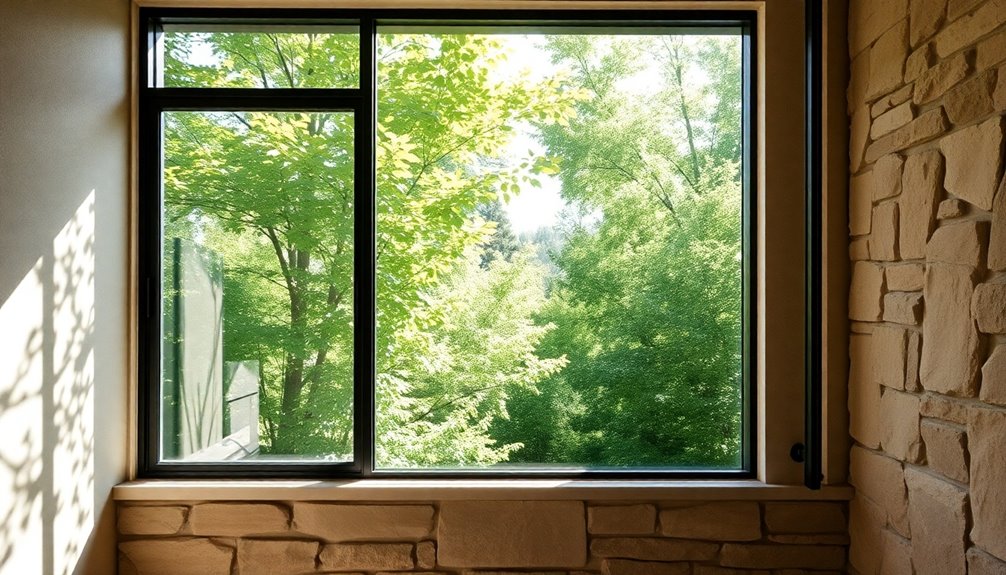
Using thermal mass in your basement can greatly enhance temperature regulation and comfort.
By incorporating materials with high thermal mass, such as concrete or stone, you can absorb heat during the day and release it at night. This helps to maintain a more stable temperature throughout the day and night, reducing the need for heating and cooling systems. Additionally, effective budgeting can help you allocate funds for these eco-friendly upgrades, maximizing your investment in energy efficiency. Furthermore, thermal mass can help to reduce humidity levels, creating a more pleasant environment in your basement. Moreover, utilizing real-time insights from energy consumption data can assist in optimizing your thermal mass strategy for better efficiency. Implementing automated savings programs can also help you save for these improvements over time.
Benefits of Thermal Mass
Thermal mass plays an essential role in regulating indoor temperatures, making your living space more comfortable and energy-efficient. By utilizing materials like concrete, brick, and stone, thermal mass absorbs heat during the day and releases it at night, maintaining a stable indoor climate. This reduces your reliance on heating and cooling systems, resulting in significant cost savings—up to 20% less energy consumption.
| Benefit | Description |
|---|---|
| Temperature Stability | Moderates indoor climate fluctuations |
| Energy Efficiency | Lowers heating and cooling costs |
| Insulating Properties | Enhances comfort by reducing drafts |
| Sustainable Living | Contributes to a more eco-friendly home |
| Long-term Savings | Reduces utility bills over time |
Material Options for Thermal Mass
Incorporating the right materials for thermal mass can greatly enhance your home's energy efficiency and comfort. Options like concrete, brick, and stone excel at absorbing, storing, and releasing heat, helping to regulate indoor temperatures.
Concrete, with its high density and heat capacity, stands out for its ability to store significant amounts of heat. You can optimize thermal mass effectiveness by positioning these materials near energy-efficient windows to capture sunlight throughout the day.
This strategic placement not only moderates temperature fluctuations but also leads to energy savings, reducing reliance on heating and cooling systems. In climates with variable temperatures, leveraging thermal mass can create more livable spaces year-round, enhancing your overall comfort while lowering your carbon footprint.
Implementation in Basements
When you implement thermal mass in your basement, you're not just enhancing energy efficiency; you're also creating a more comfortable living space. By using materials like concrete or stone, you can absorb excess heat during the day and release it at night. Strategically placing non-venting basement windows maximizes natural light while minimizing heat loss, allowing your thermal mass to work effectively.
| Aspect | Benefit |
|---|---|
| Thermal Mass Material | High heat capacity |
| Non-Venting Windows | Maximize natural light |
| Insulation | Prevent heat transfer |
| Temperature Regulation | Stabilizes indoor climate |
| Energy Savings | Up to 30% reduction in demand |
With these strategies, you'll enjoy improved comfort and indoor air quality without relying on mechanical ventilation.
Natural Insulation Materials
Natural insulation materials offer a sustainable solution for enhancing energy efficiency in your home. Options like cellulose, made from recycled paper, provide an eco-friendly choice with an impressive R-value of 3.1 to 3.8 per inch, ensuring effective thermal resistance.
Wool insulation, derived from sheep's fleece, is biodegradable and absorbs moisture without compromising its insulating properties.
Straw bales, with an R-value of around 1.5 per bale, are a renewable resource that considerably cuts down your carbon footprint.
Hemp insulation, from rapidly growing fibers, regulates temperature and humidity while maintaining a low environmental impact.
Finally, recycled denim insulation transforms post-consumer blue jeans into a non-toxic alternative, boasting an R-value of approximately 3.5 per inch, making it a smart choice for energy efficiency.
Benefits of Moisture Barriers
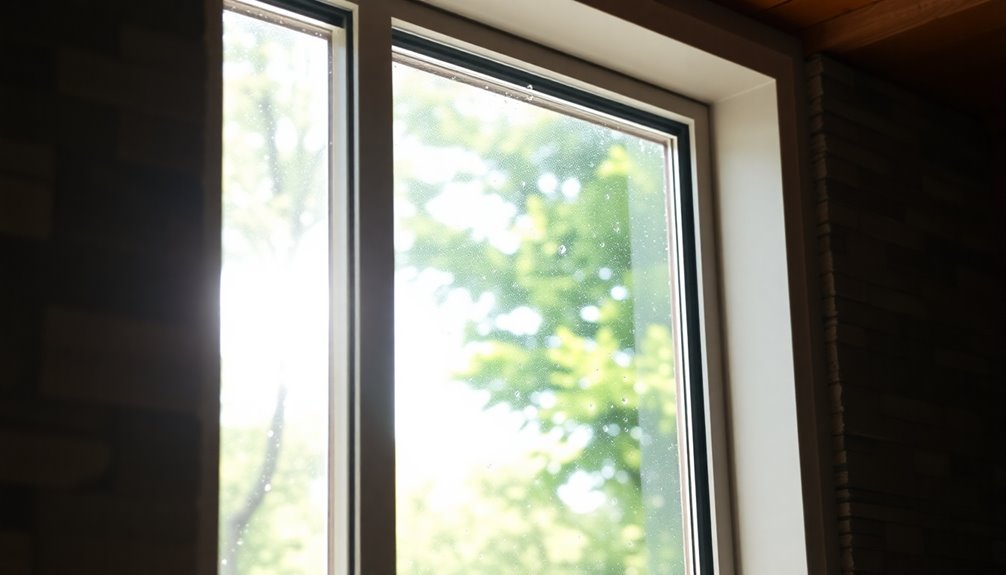
Moisture barriers play an essential role in maintaining a healthy basement environment, especially when paired with natural insulation materials. By reducing moisture penetration through basement floors, these barriers protect against mold and structural damage.
If you're a homeowner seeking a cost-effective solution, installing a moisture barrier can lower humidity levels by up to 50%, creating a more comfortable space. Covering the barrier with materials like pea gravel improves moisture control and drainage, preventing water pooling.
Additionally, combining moisture barriers with properly insulated ceilings enhances energy efficiency, keeping your basement cozy. With just a one-time investment, you can safeguard your home from long-term damage and costly repairs associated with high humidity and moisture intrusion.
Enhancing Indoor Air Quality
To enhance indoor air quality in your basement, consider the advantages of non-venting windows. These windows let in natural light while limiting moisture infiltration, reducing the risk of mold. By installing energy-efficient windows with low-E coatings, you'll minimize heat transfer and humidity levels, further improving air quality. High-performance glass blocks UV rays, protecting your furniture and reducing indoor pollutants.
| Feature | Benefit |
|---|---|
| Non-venting Windows | Limit moisture, prevent mold |
| Energy-Efficient Windows | Lower heat transfer, humidity |
| High-Performance Glass | Blocks UV rays, reduces pollutants |
| Whole-home Ventilation | Continuous air exchange |
| Regular Maintenance | Prevents leaks, controls humidity |
Combining these features creates a healthier basement environment for you and your family.
Sustainable Living Practices
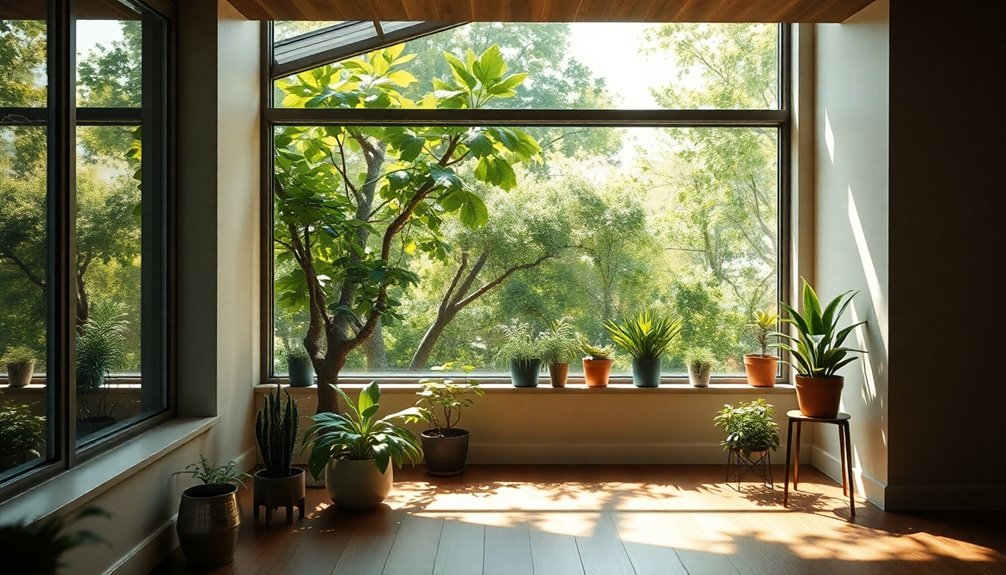
When you choose energy-efficient window options for your basement, you're not just enhancing comfort; you're also taking a step towards sustainable living.
Using eco-friendly materials and following sustainable design principles can greatly reduce your home's environmental impact.
Let's explore how these choices can lead to a healthier, greener lifestyle for you and your community.
Energy-Efficient Window Options
As you consider upgrading your basement windows, energy-efficient options can greatly enhance your home's comfort and sustainability. Look for energy-efficient windows with low-E coatings, which can reduce heat loss by up to 30%. Double or triple-pane windows filled with argon or krypton gas provide better insulation than single-pane alternatives. When planning your window replacement, opt for Energy Star certified products to guarantee compliance with energy efficiency guidelines.
| Window Type | Benefits | Eco-Friendly Aspect |
|---|---|---|
| Low-E Coated | Reduces heat loss/gain | Lowers energy bills |
| Double/Triple-Pane | Improved insulation | Decreases carbon emissions |
| Sustainable Frame | Durable and responsibly sourced | Supports eco-friendly practices |
| Energy Star | Long-term savings | Reduced environmental footprint |
Eco-Friendly Materials Use
Choosing eco-friendly materials for your basement windows not only enhances your home's aesthetic appeal but also supports sustainable living practices.
Opt for wooden frames sourced from sustainably managed forests; they're biodegradable and renewable, adding natural beauty while providing insulation.
Composite materials made from reclaimed wood fibers and recycled plastics offer durability and require minimal upkeep.
Incorporating low-E coatings can greatly boost energy efficiency, managing heat transfer effectively and reducing energy costs.
Additionally, consider window frames made from recycled aluminum, which cut down waste and promote sustainable construction.
Regular maintenance with eco-friendly sealants for wooden components guarantees longevity, minimizing replacements and further reducing your environmental impact.
Sustainable Home Design Principles
Eco-friendly materials lay the groundwork for broader sustainable home design principles that can considerably reduce your environmental footprint. By focusing on energy efficiency and environmentally responsible practices, you can create a home that benefits both you and the planet. Incorporate passive solar design with strategically placed replacement windows to optimize natural light and minimize heating and cooling costs. Utilize renewable resources like bamboo and reclaimed wood to support sustainability. Implement water-efficient technologies to conserve resources and cut utility costs.
| Principle | Benefits | Examples |
|---|---|---|
| Energy-efficient systems | Lower energy bills | Energy Star appliances |
| Passive solar design | Reduced energy consumption | Strategically placed windows |
| Renewable materials | Less waste, less deforestation | Bamboo flooring, reclaimed wood |
| Water efficiency | Conserves water resources | Low-flow fixtures, rainwater systems |
| Resource efficiency | Maximizes resource use | Recycled materials in construction |
Cost-Effective Alternatives to Mechanical Systems
While many homeowners rely on mechanical systems for ventilation and moisture control, several cost-effective alternatives can achieve similar results without the added expenses.
You can pair non-venting basement windows with passive ventilation solutions, like vents and grills, allowing natural airflow without mechanical aid.
Utilizing energy-efficient window technologies, such as low-E coatings and inert gas fills, cuts heating and cooling costs considerably.
Incorporating perforated materials in your basement construction enhances airflow while avoiding expensive systems.
Installing a heavy plastic vapor barrier and proper ground cover effectively manages moisture levels without mechanical intervention.
Regular maintenance of these eco-friendly windows, like cleaning and inspecting seals, prolongs their lifespan and efficiency, reducing the need for costly mechanical alternatives.
Planning for Long-Term Energy Efficiency
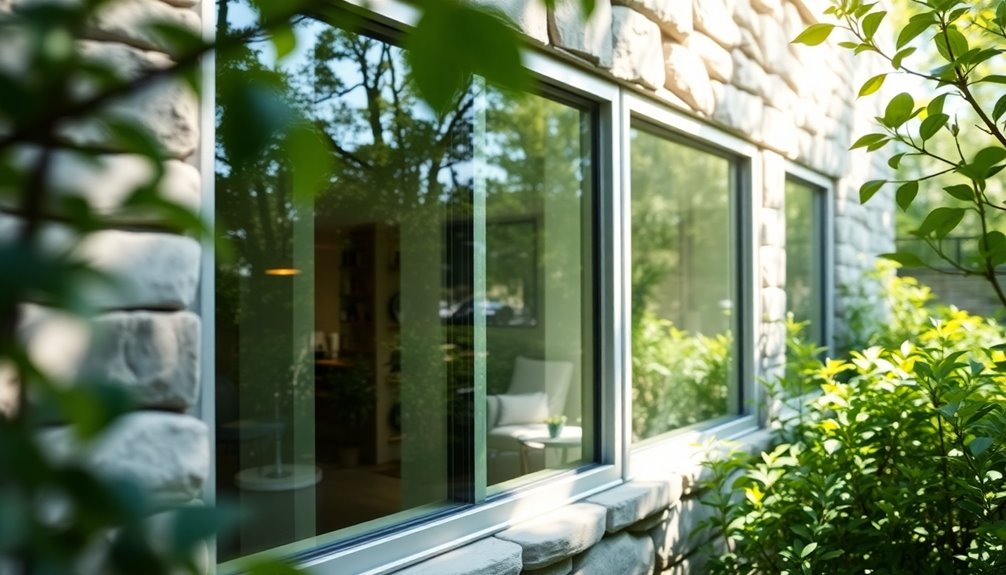
Investing in non-venting basement windows not only enhances ventilation but also sets the stage for long-term energy efficiency. By selecting double or triple-pane window options, you can reduce heat loss by up to 50%. Low-E coatings reflect heat, stabilizing indoor temperatures and cutting energy bills. Additionally, gas-filled cavities like argon or krypton improve thermal performance, leading to lower energy consumption. Choosing Energy Star certified windows can save you an average of 12% annually, ensuring significant long-term cost reductions. Standard-sized windows simplify replacements and help maintain compliance with building codes.
| Window Type | Benefits |
|---|---|
| Double-pane | Reduces heat loss by 50% |
| Triple-pane | Superior insulation |
| Low-E coated | Reflects radiant heat |
| Energy Star | 12% average energy savings |
Conclusion
In a world where fresh air meets energy efficiency, embracing non-venting basement windows can truly transform your home. While traditional ventilation often demands costly mechanical systems, eco-friendly alternatives invite sustainability into your life. Imagine a basement that balances comfort and environmental responsibility—where passive ventilation coexists with innovative thermal mass techniques. By choosing these solutions, you're not just enhancing indoor air quality; you're investing in a healthier planet for tomorrow while enjoying the cozy refuge of your basement today.

